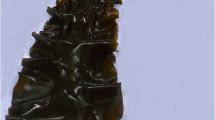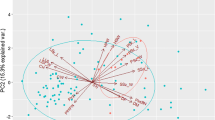Abstract
Saccharum spontaneum L. is an important wild used parent for sugarcane breeding, which can improve variety yield, ratoon ability and resistance to biotic and abiotic stress. In order to illustrate the genetic diversity of yield-related traits within a collection of S. spontaneum from Yunnan province, China, 222 clones from six geographic regions of Yunnan were screened for five yield-related traits. The results showed that: (1) the coefficient of variation (CV) of five yield-related traits ranged from 20.39 to 77.06%, of which the stalk weight exhibited the highest genetic variation with the highest CV value (77.06%), followed by the tillering rate with a CV value of 38.33%. The clones from the northwestern region of Yunnan exhibited the highest genetic variation, with an average CV value of 39.03%, followed by clones from the southwestern and southern regions; (2) the elevation and latitude of the locations from where the clones were collected had significant negative correlations with stalk height, stalk diameter and stalk weight (p < 0.01), but there was a significant positive correlation between latitude and tillering rate; (3) among six populations, there was no obvious genetic divergence because of a small divergence coefficient (Gst = 5.18%) and high gene flow (Nm = 9.1587); and (4) based on the UPGMA cluster analysis of these clones, three groups with obvious difference in four traits were obtained. Finally, the top 15 ranked clones per trait were listed in the paper for innovation utilization. The results from this study will aid in the selection of high biomass clones as wild parents for improving variety yield potential and can provide direction for the collection and management plan of S. spontaneum resources of Yunnan.

Similar content being viewed by others
References
Alwala, S., A. Suman, J.A. Arro, J.C. Veremis, and C.A. Kimbeng. 2006. Target region amplification polymorphism (TRAP) for assessing genetic diversity in sugarcane germplasm collections. Crop Science 1: 448–455.
Alphonse, A.V., R. Balakrishnan, M.J.A. William, and N. Balasundaram. 2006. Constituting a core collection of Saccharum spontaneum L. and comparison of three stratified random sampling procedures. Genetic Resources and Crop Evolution 53: 1563–1572.
Berding, N., and B.T. Roach. 1987. Germplasm collection, maintenance, and use. In Sugarcane improvement through breeding, ed. D.J. Heinz. Amsterdam: Elsevier.
Chen, H., Y.H. Fan, X.W. Shi, Q. Cai, M. Zhang, and Y.P. Zhang. 2000. Research on genetic diversity and systemic evolution in Saccharum spontaneum L. Acta Agronomica Sinica 5: 645–652.
Cuadrado, A., R. Acevedo, S.M.D. Dela- Espina, N. Jouve, L.A. De, and C. Torre. 2004. Genome remodelling in three modern S. officinarum × S. spontaneum sugarcane cultivars. Journal of Experiment Botany 398: 847–854.
Chen, R.K. 2011. Theory and practice in modern sugarcane breeding. Beijing: China Agriculture Press.
Chang, D., F.Y. Yang, J.J. Yan, Y.Q. Wu, S.Q. Bai, X.Z. Liang, and Y.M. Gan. 2012. SRAP analysis of genetic diversity of nine native populations of wild sugarcane, Saccharum spontaneum, from Sichuan, China. Genetics and Molecular Research 12: 1245–1253.
Dunckelman, P.H., and R. Breaux. 1970. New sugar cane breeding clones from Indian crosses evaluated at Houma, Louisiana, 1966–69. International Sugar Journal 72: 43–44.
Dunckelman, P. H., and B. L. Legendre. 1982. Guide to sugarcane breeding in the temperate zone. USDA-ARS, ARM-S-22, New Orleans.
D’hont, A., L. Grivet, P. Feldmann, P. Rao, N. Berding, and J.C. Glaszmann. 1996. Characterisation of the double genome structure of modern sugarcane cultivars (Saccharum spp.) by molecular cytogenetics. Molecular and General Genetics 250: 405–413.
D’hont, A. 2005. Unravelling the genome structure of polyploids using FISH and GISH; examples of sugarcane and banana. Cytogenetic and Genome Research 109: 27–33.
Fan, Y.H., H. Chen, X.W. Shi, Q. Cai, M. Zhang, and Y.P. Zhang. 2000. RAPD analysis of Saccharum spontaneum from different ecospecific colonies in Yunnan. Acta Botanica Yunnanica 3: 298–308.
Fan, L.N., H.H. Deng, Q.W. Luo, H.Y. He, Y. Li, Q.N. Wang, and Y.W. Qi. 2012. Genetic diversity of Saccharum spontaneum from geographical regions of China assessed by simple sequence repeats. Genetics and Molecular Research 4: 5916–5925.
Govindaraj, P., V.A. Amalraj, K. Mohanraj, and N.V. Nair. 2014. Collection, characterization and phenotypic diversity of Saccharum spontaneum L. from arid and semi arid zones of Northwestern India. Sugar Tech 16: 36–43.
Henry, R.J., and C. Kole. 2010. Genetics, genomics and breeding of sugarcane. Enfield, New Hampshire: Science Publishers.
Huang, Z.X., F. Zhou, Q.N. Wang, Y.F. Jin, C. Fu, H.X. Hu, C.M. Zhang, H.L. Chang, J.L. Ji, Q.W. Wu, and S.M. Liu. 2012. Genetic diversity assessment of Saccharum spontanuem L. native of domestic and overseas with phenotype agronomic traits. Journal of Plant Genetic Resources 5: 825–829.
Ji, Z., Y. Hui, Q. Cui, E. Wang, W. Chen, and W. Chen. 2015. Genetic divergence and gene flow among Mesorhizobium, strains nodulating the shrub legume Caragana. Systematic and Applied Microbiology 3: 176–183.
Liu, X.L., C.W. Wu, J. Mao, Q. Cai, X.M. Ying, and M.A. Li. 2010. Construction and evaluation on separate population from sugarcane. Southwest China Journal of Agricultural Sciences 1: 30–36.
Liu, X.L., H.S. Su, X.M. Ying, L. Ma, X. Lu, H.B. Liu, and Z.H. Deng. 2012. Phenotypic correlation and genetic diversity of decaploids of Saccharum spontaneum. Journal of Hunan Agricultural University 6: 574–579.
Li, J., P. Lin, Y. Dong, and X.H. Guo. 2013. Effect of morphology and physiology of wetland plants on plateaus at different altitudes. Plant Science Journal 4: 370–377.
Mc Dermott, J.M., and B.A. Mc Donald. 1993. Gene flow in plant pathosystems. Annual Review of Phytopathology 31: 353–373.
Mary, S., N.V. Nair, P.K. Chaturvedi, and A. Selvi. 2006. Analysis of genetic diversity among Saccharums pontaneum L. from four geographical regions of India, using molecular markers. Genetic Resources and Crop Evolution 6: 1221–1231.
Mishra, S., T.K. Nailwal, and R.C. Pant. 2014. In vitro study of role of ethylene during tillering in sugarcane. Sugar Tech 3: 255–263.
Nei, M. 1973. Analysis of gene diversity in subdivided populations. Proceedings of the National Academy of Sciences of the United States of America 12: 225–233.
Pan, Y.B., D.M. Burner, B.L. Legendre, M.P. Grisham, and W.H. White. 2005. An assessment of the genetic diversity within a collection of Saccharum spontaneum L. with RAPD-PCR. Genetic Resources and Crop Evolution 8: 895–903.
Qiu, C.L., S.C. He, and S.Q. Yang. 1987. Studies on saccharum spontaneum from Yunnan II study on esterase isozymes. Journal of Yunnan Agricultural University 2: 80–83.
Qi, Y.W., L.N. Fan, H.Y. He, Y.S. Chen, J.H. Ao, and H.H. Deng. 2009. Genetic diversity assessment of Saccharum spontaneum L. native to Guangdong area with agronomic traits. Sugarcane and Canesugar 3: 7–10.
Qi, Y.W., L.N. Fan, Q.W. Luo, Q.N. Wang, Y.S. Chen, Z.X. Huang, and Q.W. Li. 2013. Establishment of Saccharum spontaneum L. core collections. Acta Agronomica Sinica 4: 649–656.
Reed, G.F., F. Lynn, and B.D. Meade. 2003. Use of coefficient of variation in assessing variability of quantitative assays. Clinical and Diagnostic Laboratory Immunology 6: 1235–1239.
Su, H.S., X.L. Liu, X.M. Ying, J. Mao, X. Lu, L. Ma, Y.H. Fan, and Q. Cai. 2011. Sampling strategy of pre-core collection for Saccharum spontaneum. Journal of Hunan Agricultural University 3: 253–259.
Tai, P.Y.P., J.D. Miller, and B.L. Legendre. 1994. Preservation of Saccharum spontaneum germplasm through storage of true seed. Sugar Cane 6: 3–8.
Tai, P.Y.P., and J.D. Miller. 2001. A core collection for Saccharum spontaneum L. from the world collection of sugarcane. Crop Science 3: 879–885.
Tai, P.Y.P., and J.D. Miller. 2002. Germplasm diversity among four sugarcane species for sugar composition. Crop Science 42: 958–964.
Tao, L.A., Y.F. Jing, L.H. Dong, A.N. Ru-Dong, L.H. Yang, and Q.M. Zhou. 2011. Genetic analysis of main traits in descendants of crossing with saccharum spontaneum 82-114 in yunnan. Journal of Plant Genetic Resources 3 (4): 19–424.
Tao, L.A., A.N. Ru-Dong, L.H. Yang, Y.F. Jing, L.H. Dong, and Q.M. Zhou. 2014. Integrated evaluating and classifying of the similarity-difference analysis for the generation F2 (BC1) from Saccharum spontaneum ‘yunnan 82-114′. Journal of Tropical & Subtropical Botany 6: 590–600.
Tam, N.M., V.D. Duy, M. Nguyen, and V.D. Giap. 2014. Genetic diversity in the natural populations of dipterocarpus costatus (dipterocarpaceae). Research Journal of Biotechnology 8: 14–19.
Wu, C.W., P. Jackson, J.Y. Liu, P.F. Zhao, J. Zhao, and Y.H. Fan. 2011. Inheritance of quality traits of the distant crossing between S. officinarum and S. spontaneum. Journal of Plant Genetic Resources 1: 59–63.
Zhang, G.M., R.Z. Yang, H.B. Liu, and W.K. Fang. 2006. Principal component analysis for 7 quantitative traits and cluster analysis based on 7 quantitative traits of Saccharum spontaneum L. Southwest China. Journal of Agricultural Science 6: 1127–1131.
Zhang, G.M., Y.R. Li, W.Z. He, H. He, X.H. Liu, H.Z. Song, and W.K. Fang. 2010. Analysis of the genetic diversity in Saccharum spontaneum L. accessions from Guangxi province of China with RAPD-PCR. Sugar Tech 12: 31–35.
Acknowledgements
This work was supported by the Nation Natural Science Foundation of China (31540084, 31360359), the Open Fund of Yunnan Key Laboratory of Sugarcane Genetic Improvement (2015DG015-04) and Candidates of the Young and Middle Aged Academic Leaders of Yunnan Province (2014HB038). We would aslo like to thank LetPub (www.letpub.com) for its linguistic assistance during the preparation of this manuscript.
Authors’ Contributions
Xinglong Liu and Huosheng Su conceived and designed the experiments. Chaohua Xu, Hong bo Liu, Xiuqin Lin and Qiuyan Zi performed the experiments. Chaohua Xu, Huosheng Su and Xiuqin Lin analyzed the data. Xin Lu, Chunjia Li and Jun Mao contributed reagents/materials/analysis tools. Chaohua Xu, Huosheng Su and XuJuan Li wrote the manuscript.
Author information
Authors and Affiliations
Corresponding author
Ethics declarations
Conflict of interest
The authors have declared that no competing interests exist.
Rights and permissions
About this article
Cite this article
Xu, C., Su, H., Liu, H. et al. An Assessment of Genetic Diversity of Yield-Related Traits of Saccharum spontaneum from Yunnan Province, China. Sugar Tech 19, 458–468 (2017). https://doi.org/10.1007/s12355-016-0505-3
Received:
Accepted:
Published:
Issue Date:
DOI: https://doi.org/10.1007/s12355-016-0505-3




